Pi Alley (Boston)
Coordinates: 42°21′29.67″N 71°3′32.37″W / 42.3582417°N 71.0589917°W
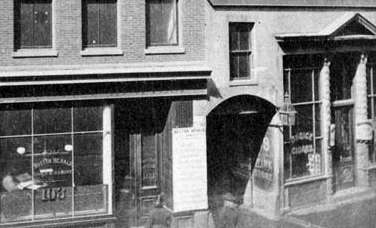
Entrance to Pi Alley "through the arch at 103 Washington Street," Boston, 19th century[1]
Pi Alley (often misspelled Pie Alley) in Boston, Massachusetts, is located off Washington Street, near the Old City Hall on School Street. The origin of the short street's name remains in question. It may be called "Pi Alley" "because of the dumping into it of the pied type from newspaper composing rooms years ago", or "Pie Alley" "because of restaurants that sold a piece of pie and a cup of coffee for a nickel."[2][3] It is also known as Williams Court, Savage's Court, Peck's Arch, and Webster's Arch.[4][5][6]
History
Through the years, tenants have included:
- The Bell-in-Hand (est. 1795) was "a faithful reproduction of the taverns fashionable in London" in the 18th century.[7][8]
- Boston Herald[9]
- Boston police (c. 1854), corner of Court Square and Williams Ct.[10]
- Private residences in 1832 of a clerk, colorer, cordwainer, handcartman, housewright, mariner, nurse, truckman, wheelwright, and several laborers, printers, and widows[11]
- David Francis (1779-1853), printer, publisher (Munroe & Francis)[12]
- "Oakum pickers tenement" (c. 1711). "In 1711, Oct. 2, a fire commenced in Williams' Court in an oakum pickers tenement, where the woman suffered the fire 'to catch the oakum she was employed in picking of;' all the houses and stores on both sides of Washington St. between School St. and Dock Square were laid in ashes."[13]
- Life in Boston, a weekly periodical (c. 1851)[14]
- Samuel Sewall (c. 1727). "Monday, July 10th, 1727, removed with my family to Boston. Hired a house in Deacon Williams Court next house to Deacon Williams, N. Gates and N. Gleason, bringing my household stuff."[15]
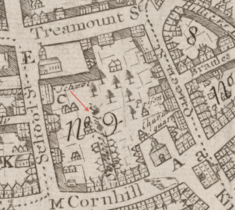 Detail of 1743 map of Boston, showing Savage's Court
Detail of 1743 map of Boston, showing Savage's Court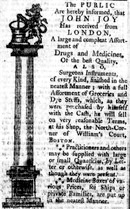 Drugs and medicines, 1774
Drugs and medicines, 1774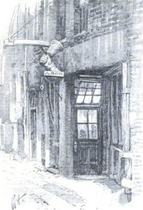 Bell-in-Hand, established 1795
Bell-in-Hand, established 1795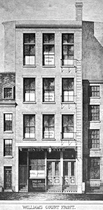 Boston Herald, Williams Court, 19th century
Boston Herald, Williams Court, 19th century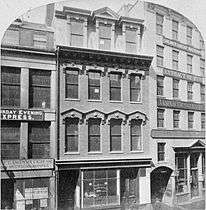 Entrance to Pi Alley on Washington St., 19th century
Entrance to Pi Alley on Washington St., 19th century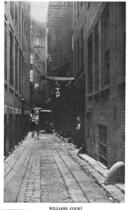 Pie Alley, Boston, c. 1920
Pie Alley, Boston, c. 1920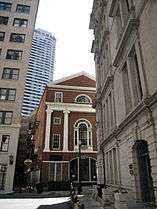 Entrance to Pi Alley, behind Old City Hall, 2010
Entrance to Pi Alley, behind Old City Hall, 2010
See also
References
- ↑ Boston Directory. 1832
- ↑ Warning on Pi Alley; Boston Byway Posted as Private but Traffic Goes On. New York Times, January 11, 1922.
- ↑ Boston Globe Guide to Boston. 2005
- ↑ Boston Street Laying-Out Dept. A record of the streets, alleys, places, etc. in the city of Boston]. Boston: City Printing Dept., 1910.
- ↑ Edward Hartwell Savage. Boston events: Boston for 250 years, from Blackstone to O'Brien. Boston: Mutual News Co., 1886.
- ↑ http://www.cityofboston.gov/publicworks/streetbook/ Retrieved 2010-05-29
- ↑ John F. Murphy. Up-to-date guide book of greater Boston. Boston: Murphy, 1904; p. 60
- ↑ "The Bell-in-Hand, 1795: Boston's Oldest Tavern". Caledonian (NY), v. 11, no. 4, Aug. 1911; pp. 166–167.
- ↑ Bostonian Society. Old Boston in early photographs, 1850-1918. Dover Publications, 1990; p.16.
- ↑ Edward Hartwell Savage. Boston events: Boston for 250 years, from Blackstone to O'Brien. Boston: Mutual News Co., 1886.
- ↑ Boston Directory. 1832
- ↑ Roberts. History of the Military company of the Massachusetts, now called the Ancient and honorable artillery company of Massachusetts. 1637-1888, Volume 2. Boston: A. Mudge & son, printers, 1897; p.333-334
- ↑ Dearborn's reminiscences of Boston. 1851; p.32
- ↑ Dearborn's reminiscences of Boston. 1851; p.90
- ↑ Sewall, quoted in: "Early Reminiscences." City Record and Boston News-Letter, Jan. 21, 1826
External links
| Wikimedia Commons has media related to Pie Alley (Boston). |
- Google news archive. Articles about Pi Alley; Pie Alley; Williams Court
- Flickr. Photo of Washington St. from the Pi Alley Garage, mid-1970s
- View East from Pi Alley, Boston, 2008, photo by Nicholas Nixon
- Flickr. Photo of Pi Alley, 2008
- Flickr. Photo of Pi Alley, 2008
- Flickr. Photo of Pi Alley, 2009
- Flickr. Photo of Pi Alley, 2010
This article is issued from
Wikipedia.
The text is licensed under Creative Commons - Attribution - Sharealike.
Additional terms may apply for the media files.